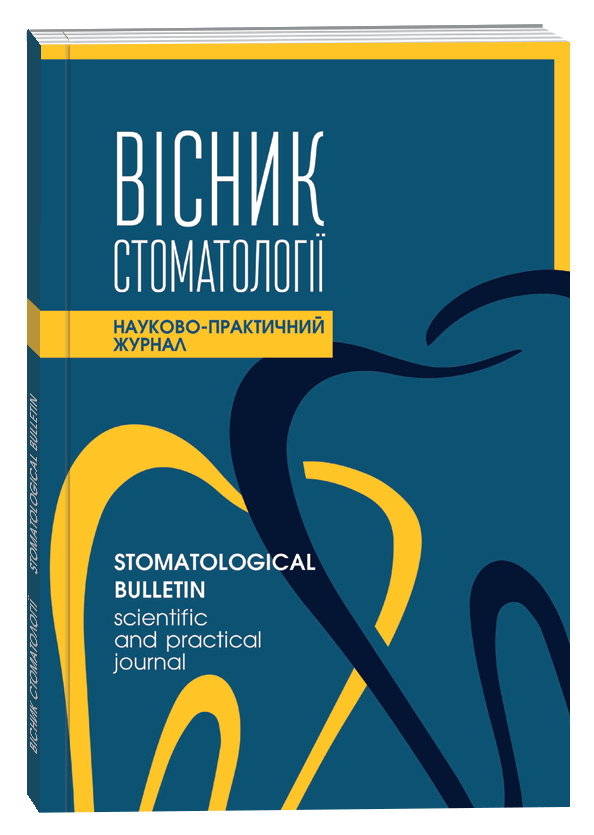CLINICAL AND LABORATORY JUSTIFICATION OF PREVENTION OF DENTAL PULP INFLAMMATION AFTER ODONTOPREPARATION
DOI:
https://doi.org/10.35220/2078-8916-2023-48-2.2Keywords:
prevention, bioflavonoids, minerals, hyaluronic acid, odontopreparationAbstract
It is known that preserving the vitality of teeth that support fixed orthopedic structures has an undeniable clinical and biological advantage from the point of view of predicting long-term results of orthopedic treatment, and can significantly improve the quality of dental care provided. According to various authors, complications after the preparation of vital supporting teeth for metal– ceramic prostheses occur in 4.2–17.7 % of cases. The article presents the results of a study of the functional state of the pulp after odontopreparation for fixed orthopedic structures. An analysis of electrical excitation of the pulp was carried out, as a result of which it was proved that the use of the proposed complex significantly reduces inflammatory reactions in the tooth pulp, increases its resistance after odontopreparation. Purpose of the work. Assessment of the functional state of the pulp as a result of the use of a complex of hyaluronic acid, bioflavonoids and minerals to increase the effectiveness of preventing complications after odontopreparation under fixed orthopedic structures. Materials and methods of research. The total number of patients examined for the clinical part of the study was 80 people, who were divided into two groups: and the main group – 40 patients, in whom we used the therapeutic and preventive complex with the use of gel «Kvertgial», zinc oxide powder, HYDROCAL to fix temporary fixed dentures. The preparations were mixed ex tempore in equal proportions until a homogeneous paste was obtained. The finished paste was used to treat the exposed surface of dentin and fix temporary crowns. Group II: comparison – 40 patients who used traditional fixing materials to fix temporary fixed dentures. A total of 234 teeth were prepared for cast, metal composite and cermet crowns. Conclusion. The proposed approach for fixing temporary NZP structures stimulated the restoration of nerve elements of the pulp that underwent pathological changes as a result of odontopreparation.
References
Gerbert, Shillinburg, David A.Sathet, Edwin L Wilson, Joseph R.Cain, Donald L. Mitchell, Luis J. Blanco & James C.Kessler (2012). Fundamentals of Fixed Prosthodontics. retrived from https://books-library.net/files/download-pdf-ebooks.org-1519394600Iu5G8.pdf.
Albers, H.F. (2006). Dentine and sensitivity. Adept. Report, V.4. P.10-11.
Cury, J.A., Simxes, G.S., Del, Bel Cury A.A. & Goncalves, N.C. (2005). Effect of calcium carbonatebased dentifrice on in situ enamel remineralization. Caries Res., 39, 255-257.
Hutchens, S.A., Benson, R.S., Evans, B.R., O'Neill, H.M. & Raun, C.J. (2006). Biomimetic synthesis of calcium-deficient hydroxyapatite in a natural hydrogel. Biomaterials. 26. P.4661-4670.
Kielbassa, A.M., Helwig, E. & Meyer-Lueckel, H. (2006). Effects of irradiation on in situ remineralization of human and bovine enamel demineralized in vitro. Quintessenz, 40, 130-135.
Lynch, R.J.M., & Cate, J.M. (2006). Effect of calcium glycerophosphate on demineralization in an in vitro biofilm model. Caries Res., 40, 142-147.
Tagliaferro, E.P.S., Rodrigues, L.K.A., Nobre dos Santos M., Soares L.E.S., & Martin A.A. (2007). Combined effects of carbon dioxide laser and fluoride on demineralized primary enamel: an in vitro study. Caries Res., 41, 74-76.
Trope, M., McDougal, R., Levin, L. & et al. (2002). Capping the inflamed pulp under different clinical conditions. J Esthet Restor Dent., 14, 349-357 doi: 10.1111/j.1708-8240.2002.tb00177.x.









